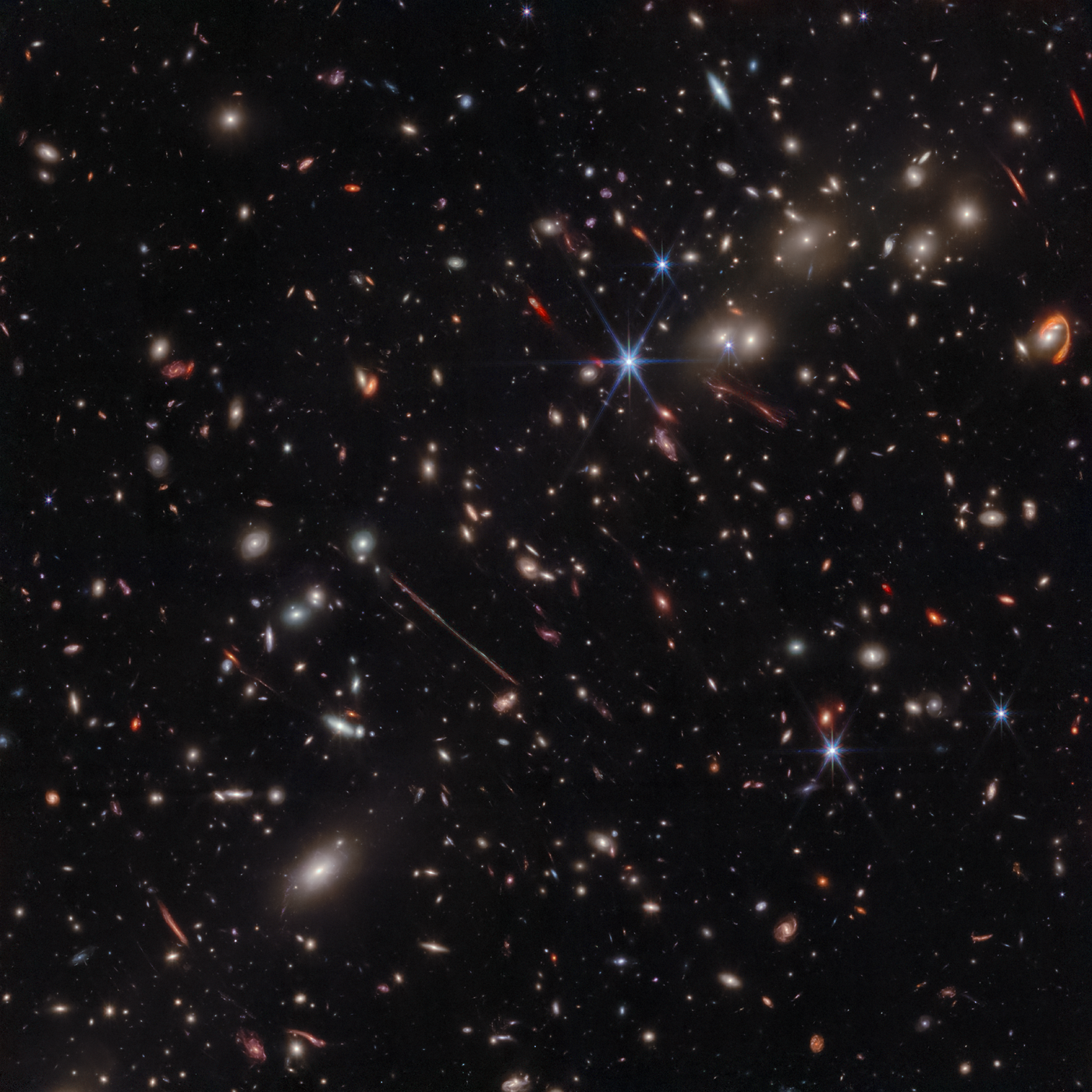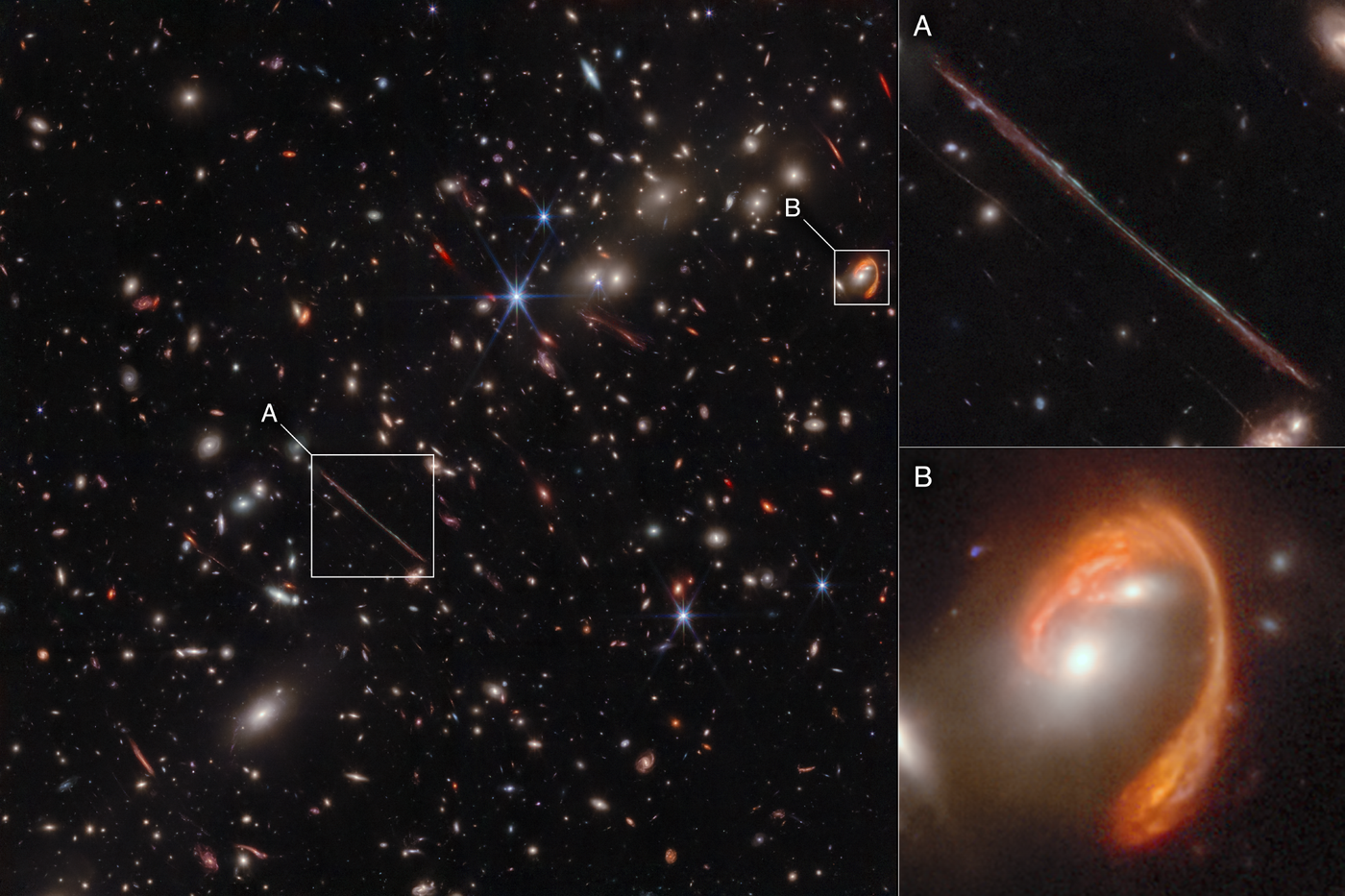NASA’s James Webb Space Telescope (JWST) recently imaged a massive galaxy cluster called “El Gordo” (Spanish for “The Fat One”) that contains hundreds of galaxies and existed when the universe was only 6.2 billion years old. El Gordo is being labeled as a “cosmic teenager” given the current age of the universe is approximately 13.8 billion years old. The four recent studies published about El Gordo hold the potential to help astronomers better understand both the formation and evolution of galaxies that existed in the early universe.
Infrared image of the galaxy cluster El Gordo (“the Fat One”) taken by NASA’s James Webb Space Telescope that displays hundreds of galaxies, some seen for the first time with such detail. El Gordo mass allows it to take advantage of the gravitational lensing effect where it distorts and magnifies light from distant background galaxies. (Credit: NASA, ESA, CSA. Science: Jose Diego (Instituto de Física de Cantabria), Brenda Frye (University of Arizona), Patrick Kamieneski (Arizona State University), Tim Carleton (Arizona State University), and Rogier Windhorst (Arizona State University). Image processing: Alyssa Pagan (STScI), Jake Summers (Arizona State University), Jordan D’Silva (University of Western Australia), Anton Koekemoer (STScI), Aaron Robotham (University of Western Australia), and Rogier Windhorst (Arizona State University))
The four studies discussing El Gordo are Frye et al., Kamieneski et al., and Carleton et al., which were each published in The Astrophysical Journal, and Diego et al., which was published in Astronomy & Astrophysics. The researchers chose to study El Gordo due to its gravitational lensing properties, which means it acts as a giant magnifying glass capable of distorting the light from objects behind it, bringing them into view for astronomers to further examine.
“Lensing by El Gordo boosts the brightness and magnifies the sizes of distant galaxies,” said Dr. Brenda Frye, who is an associate professor in the Department of Astronomy at the University of Arizona, lead author of the Frye et al. paper. “This lensing effect provides a unique window into the distant universe.” Dr. Frye is also co-lead of the PEARLS-Clusters branch of the Prime Extragalactic Areas for Reionization and Lensing Science (PEARLS) team.
As an example of how El Gordo’s lensing is being used to study the formation and evolution of early galaxies is “El Anzuelo” (Spanish for “The Fishhook”), which is located approximately 10.6 billion light-years from Earth and visible as a bright red arc in the upper right portion of the Webb image. This arc appearance is from the light distortion effect caused by El Gordo and the red color is derived from a combination of the dust reddening within El Anzuelo and what’s known as cosmological redshift due to the enormous distance to the galaxy.
After normalizing the distortions to a more normal shape, the team determined that El Anzuelo was a disk-shaped galaxy but only 26,000 light-years across. For context, our Milky Way Galaxy is just over 100,000 light-years across. The team also learned about this small galaxy’s formation history, to include it experiencing quenching, which is a phenomena in astronomy when the formation of stars within a galaxy’s center begins to decrease rapidly.
Additional objects of interest within the Webb image include “La Flaca” (Spanish for “The Thin One”) and five lensed galaxies which could be a small galaxy cluster that existed approximately 12.1 billion years ago, along with an additional 12 galaxies that might be members of this same cluster, as well. These objects were identified by a team led by Dr. Frye and consisted of nine students ranging from high school to graduate students.
Two features that stand apart in the Webb image include the Thin One (Box A), and the Fishhook (Box B). Both are lensed background galaxies caused by the gravitational lensing effect produced by El Gordo. (Credit: NASA, ESA, CSA. Science: Jose Diego (Instituto de Física de Cantabria), Brenda Frye (University of Arizona), Patrick Kamieneski (Arizona State University), Tim Carleton (Arizona State University), and Rogier Windhorst (Arizona State University). Image processing: Alyssa Pagan (STScI), Jake Summers (Arizona State University), Jordan D’Silva (University of Western Australia), Anton Koekemoer (STScI), Aaron Robotham (University of Western Australia), and Rogier Windhorst (Arizona State University))
“While additional data are required to confirm that there are 17 members of this cluster, we may be witnessing a new galaxy cluster forming right before our eyes, just over a billion years after the big bang,” said Dr. Frye.
What new discoveries will astronomers make about distant galaxies and their formation and evolutionary processes in the coming years and decades? Only time will tell, and this is why we science!
As always, keep doing science & keep looking up!







